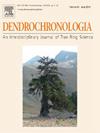Drought resilience of three coniferous species from Belgian arboreta highlights them as promising alternatives for future forests in Western Europe
IF 2.7
3区 农林科学
Q1 FORESTRY
引用次数: 0
Abstract
Searching for drought tolerant species is one of the adaptative management measures that could be implemented to improve forest resilience in the context of more intense and frequent droughts brought be climate change. Western European forests are already suffering from drought-induced tree mortality, in native as well as in well-established non-native species. Novel non-native species (i.e., non-native species that have not yet undergone thorough operational testing or previously been grown at forestry scale) with high drought resistance in their original geographic range could be an alternative. To this end, the ecology and drought response of these species need to be investigated in their area of introduction. We applied a dendroecological approach on trees of Abies nordmanniana (Steven) Spach (AN), Chamaecyparis lawsoniana (A.Murray bis) (CL), and Thuja plicata Donn ex. D.Don. (TP) from Belgian arboreta (Western Europe). First, we identified the main climatic drivers of species radial growth, using Bootstrapped Correlation Coefficients between tree ring indices and climate indicators related to drought, heat, and cold stresses. Second, we assessed the species growth response to exceptional drought events, using resistance, recovery and resilience indices and an integrated index comparing the actual resilience to a theoretical full resilience. We investigated the effects of species and drought timing on these indices using linear mixed models. The radial growth of the three species was negatively influenced by the water deficit during the previous growing season (especially in fall and summer), lower precipitation in the previous October, colder temperatures in late winter-early spring, and lower minimal temperatures in May. TP is the most sensitive species to previous summer conditions as it was negatively affected by the number of days with a mean temperature above 30°C, while AN was the least sensitive species with no significant Bootstrapped Correlation Coefficients for previous summer precipitation and temperatures. AN and TP differed from CL in being negatively affected in spring by higher maximal temperatures versus lower precipitation respectively. The effects of species and drought timing on resistance and recovery were significant. Overall, early and whole growing season droughts had a stronger negative effect than late droughts. AN and CL were more resistant to early and late droughts than TP, while the opposite was observed for recovery. The species showed less pronounced differences in resilience. CL was the species the closest to the theoretical full resilience, followed by AN: these two species appear to be good candidates for improving drought resistance of Western European forests. However, one must not forget that introducing novel species is associated with ecological risks and a thorough assessment of these risks must be carried out before promoting these species in forestry. Future research could focus on a comparison of novel non-native species with already well-established species in Western Europe such as Norway spruce and Douglas fir and explore how AN, CL and TP interact with native species in mixed stands.
来自比利时树木的三种针叶林物种的抗旱能力突出表明它们是西欧未来森林的有希望的替代品
寻找耐旱树种是在气候变化带来的干旱更加强烈和频繁的背景下,提高森林恢复力的适应性管理措施之一。西欧的森林已经遭受干旱引起的树木死亡,无论是本地树种还是已确立的非本地树种。在其原始地理范围内具有高度抗旱性的新型非本地物种(即尚未经过彻底的操作测试或以前以林业规模种植的非本地物种)可能是一种替代方案。为此,需要在引种地对这些物种的生态和干旱响应进行研究。采用树木生态学方法研究了北冷杉(Abies nordmanniana, Steven) Spach (AN)、长臂猿(Chamaecyparis lawsoniana, a.m urry bis) (CL)和白桦树(Thuja plicata Donn ex. d.d don)。(TP)源自比利时arboreta(西欧)。首先,利用树木年轮指数与干旱、热、冷胁迫相关气候指标之间的自举相关系数,确定了影响树种径向生长的主要气候因子。其次,利用抗旱性、恢复力和恢复力指数,以及比较实际恢复力和理论完全恢复力的综合指数,评估了物种生长对异常干旱事件的响应。采用线性混合模型研究了物种和干旱时间对这些指标的影响。前一个生长季(尤其是秋夏季)水分亏缺、前10月降水偏少、冬末早春较冷、5月最低气温较低对3种植物径向生长均有负向影响。TP对前夏季条件最敏感,平均气温高于30°C的日数对其最敏感,而AN对前夏季降水和温度的自引导相关系数不显著,对前夏季条件最不敏感。春季最高气温升高对氮磷和全磷的负面影响与最低降水量不同。品种和干旱时间对抗性和恢复的影响显著。总体而言,早期和整个生长季干旱的负面影响强于后期干旱。对早、晚干旱的抗旱性,全氮和全氯比TP强,而对恢复的抗旱性则相反。这两个物种在恢复力方面表现出不太明显的差异。CL是最接近理论完全恢复力的物种,其次是AN:这两个物种似乎是提高西欧森林抗旱性的良好候选者。然而,我们不能忘记,引入新物种会带来生态风险,在将这些物种推广到林业之前,必须对这些风险进行彻底的评估。未来的研究可以将重点放在新的非本地物种与西欧已经建立的物种(如挪威云杉和道格拉斯冷杉)的比较上,并探索混合林中AN、CL和TP如何与本地物种相互作用。
本文章由计算机程序翻译,如有差异,请以英文原文为准。
求助全文
约1分钟内获得全文
求助全文
来源期刊

Dendrochronologia
FORESTRY-GEOGRAPHY, PHYSICAL
CiteScore
5.50
自引率
13.30%
发文量
82
审稿时长
22.8 weeks
期刊介绍:
Dendrochronologia is a peer-reviewed international scholarly journal that presents high-quality research related to growth rings of woody plants, i.e., trees and shrubs, and the application of tree-ring studies.
The areas covered by the journal include, but are not limited to:
Archaeology
Botany
Climatology
Ecology
Forestry
Geology
Hydrology
Original research articles, reviews, communications, technical notes and personal notes are considered for publication.
 求助内容:
求助内容: 应助结果提醒方式:
应助结果提醒方式:


